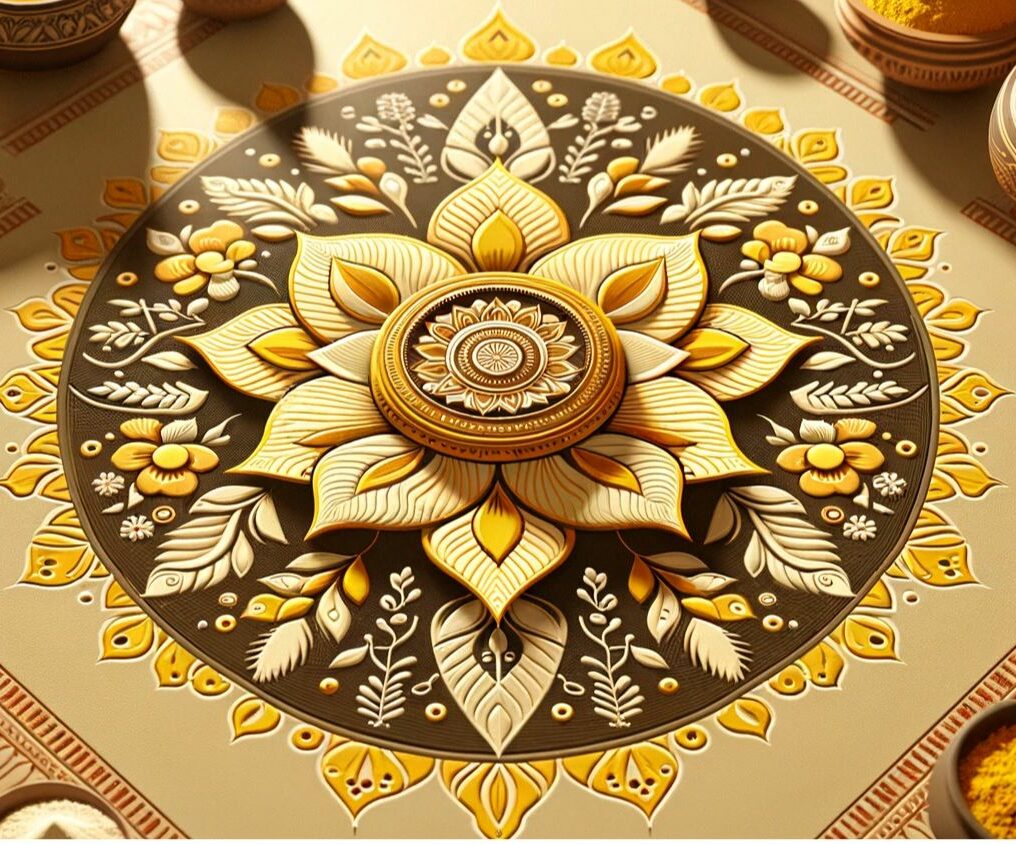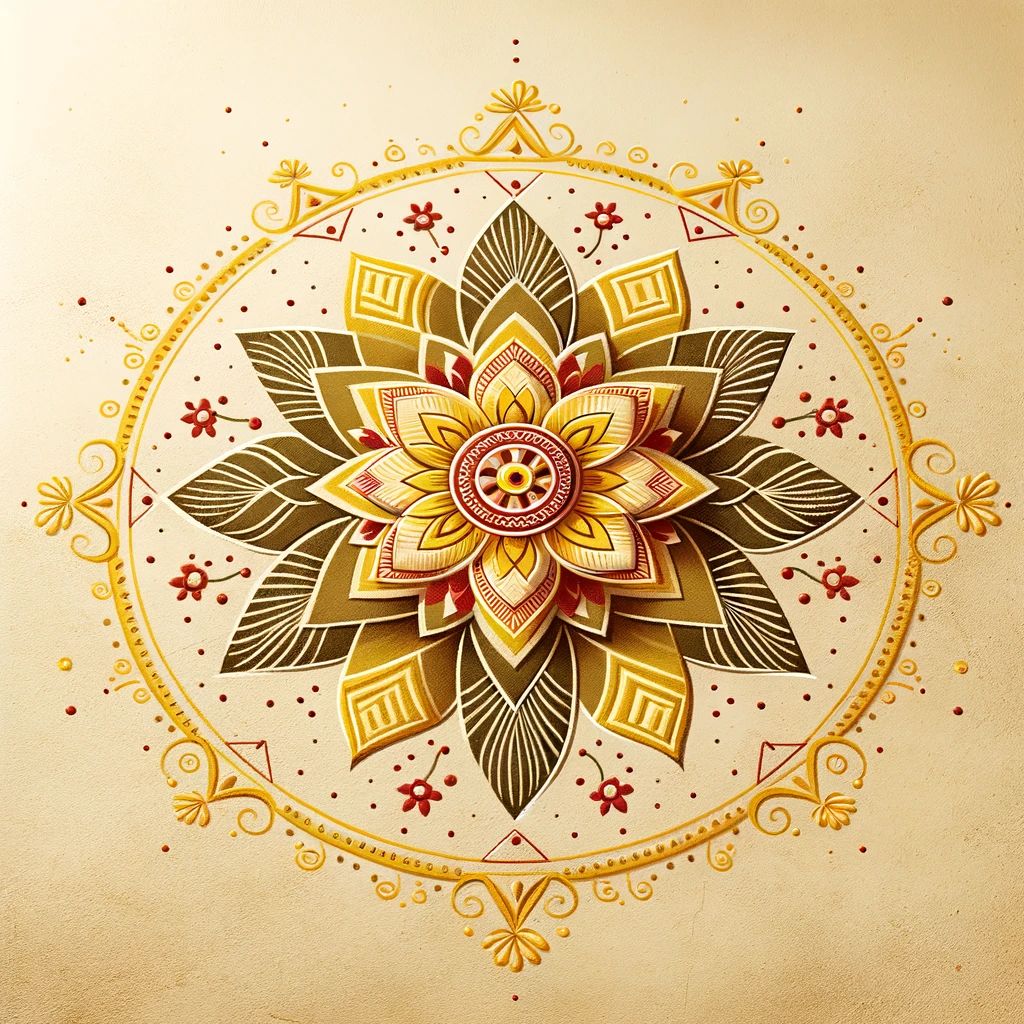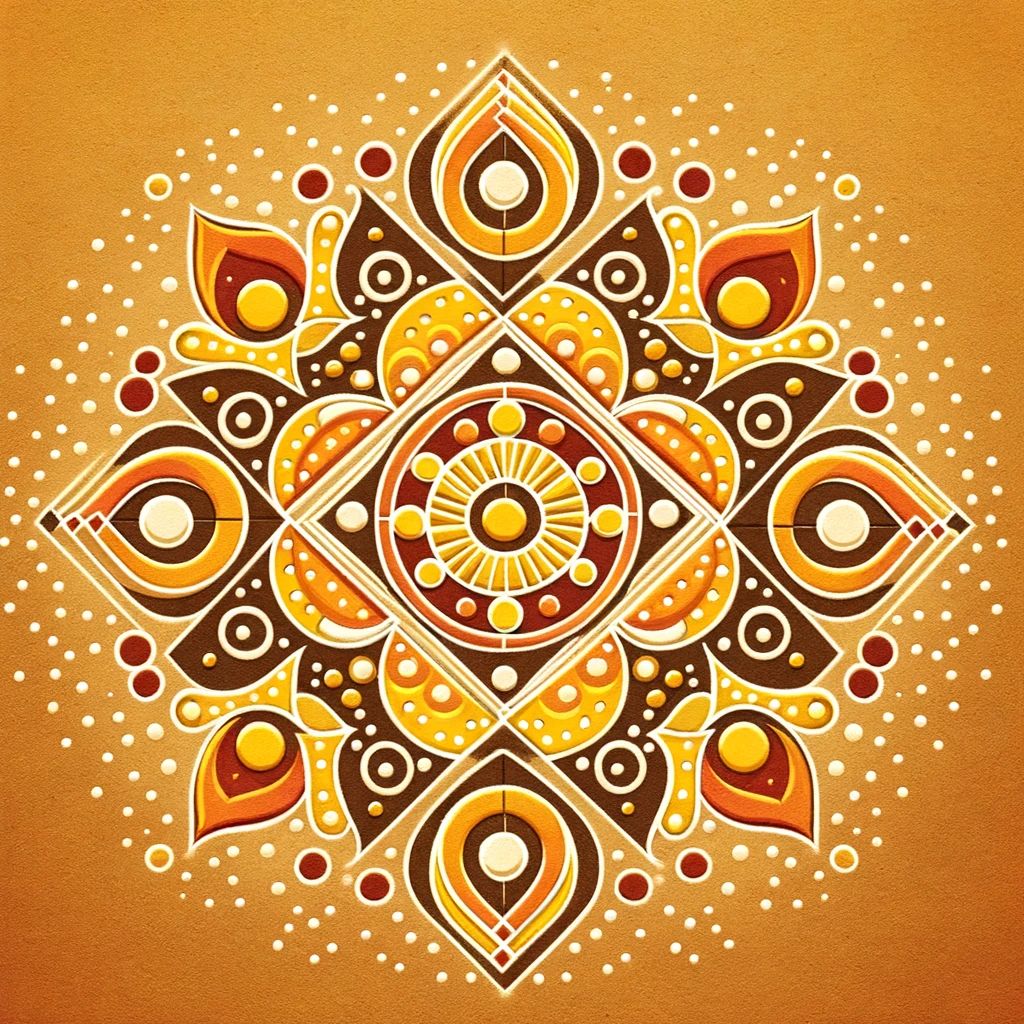Table of Contents
Makar Sankranti Rangoli
Makar Sankranti, an Indian festival observed by several states around mid-January, is a harvest festival that symbolizes the sun’s shift into Capricorn. This celebration is filled with excitement and joy, with one of the favored ways to embellish homes being the creation of rangolis. Makar Sankranti rangolis are vibrant designs fashioned on the floor using colored rice, sand, or flower petals. There are various rangoli for Makar Sankranti patterns that people utilize to adorn their homes, including Makar Sankranti Haldi Kunku special rangoli, freehand rangoli, and special rangoli designs.
How to Make Makar Sankranti Rangoli
Creating a traditional Makar Sankranti Rangoli is a wonderful way to celebrate this auspicious festival. Here’s a step-by-step guide to help you make one:
Materials you will need to make Rangoli on Makar Sankranti :
- Rangoli Powder: Available in various colors or natural ingredients like turmeric for yellow and rice flour for white.
- Chalk or Pencil: For sketching your design.
- Tray or Paper Cone: To hold and pour the Rangoli powder.
- Optional: Flowers and Diyas for decoration.
Steps to Make a Makar Sankranti Rangoli:
- Choose a Design: You can find Makar Sankranti-themed designs online or create your own, incorporating elements like the sun, kites, and sugarcane.
- Select the Location: Start by cleaning and wetting the floor where you want to create your Rangoli. A smooth, flat surface works best.
- Sketch the Design: Use chalk or a pencil to lightly draw your chosen design. This step is especially helpful for beginners to achieve a neat finish.
- Fill in with Colors: Begin filling in the design with your Rangoli powder, starting from the inside and working outward. You can use a paper cone or your fingers for precision.
- Shading and Detailing: Add depth to your design by using various shades of the same color. You can also incorporate contrasting colors for added vibrancy and detail.
- Outline the Design: After completing the filling, outline your design with a contrasting color. This step adds a neat and finished look to your Rangoli.
- Add Decorative Elements: Enhance your Rangoli by decorating it with flowers, diyas, or small lamps, especially if you plan to showcase it during an evening celebration.
Tips for a Perfect Makar Sankranti Rangoli:
- Practice First: If you’re new to Rangoli making, practice your design on paper before applying it on the floor.
- Seek Symmetry: To achieve a balanced look, make sure your design is symmetrical.
- Use a Fine Sieve: If your Rangoli powder is lumpy, pass it through a fine sieve to ensure a smoother application.
- Be Patient: Crafting a Rangoli is a delicate art that requires patience and a steady hand.
Feel free to explore various Makar Sankranti Rangoli designs and colors to create a beautiful and traditional decoration for this special occasion.
Makar Sankranti Haldi Kunku Special Rangoli
These are Makar Sankranti rangoli images specially Makar Sankranti Haldi Kunku rangoli:
1. Makar Sankranti Haldi Kunku Special Rangoli

2. Rangoli for Makar Sankranti Haldi Kunku

Makar Sankranti Rangoli Designs
- Makar Sankranti Rangoli is a widely enjoyed art form during the Makar Sankranti festival, which adds a festive charm to homes and celebrations. There are various designs and patterns that can be crafted with rangoli, and here are some popular ones:
- Colorful Sankranti Rangoli with Kalash: This design features a vibrant rangoli pattern with a traditional Indian lamp called Kalash at its center. The Kalash serves as the focal point, around which the attractive design is created. It’s a simple yet visually pleasing option.
- Circular Rangoli Designs: Circular rangoli designs are quite popular because they are easy to make and result in beautiful patterns. You can use materials like colored rice, sand, or flower petals to create these designs.
- Makar Sankranti Special 8×8 Dots Rangoli Designs for Beginners: This design is perfect for newcomers to rangoli art. It involves a straightforward 8×8 grid pattern with dots at the center, making it easy to follow and create an appealing design.
- Intricate Designs for Experts: For those with more experience in making rangolis, intricate designs provide a challenging and rewarding project. This Makar Sankranti special design allows you to showcase your skills and creativity.
- Stellar Design with Everyday Tools: This design is suitable for those who lack specialized rangoli tools. It demonstrates how to create a beautiful design using everyday items found around the house, making it an accessible option for everyone.
Below are some easy and simple Makar Sankranti rangoli designs:
Makar Sankranti Rangoli Easy

Simple Rangoli for Makar Sankranti

Makar Sankranti Special Rangoli Design
Rangoli for Makar Sankranti Haldi Kunku

Makar Sankranti Rangoli 2024

Tips to Make Makar Sankranti Rangoli
These are some tips which help you to create rangoli for Makar Sankranti:
- Selecting a Design: Start by choosing a design that captures the spirit of Makar Sankranti, incorporating elements such as the sun, kites, sugarcane, or traditional patterns. You can find design ideas online or create your own.
- Choosing the Location: Clean and prepare a flat surface where you want to create your rangoli. It’s best to place it near the entrance of your home or in a prominent spot where it can be easily seen.
- Sketching the Design: Use chalk or a pencil to lightly draw your chosen design on the floor. This initial sketch will act as a guide for filling in the rangoli with colors.
- Gathering Materials: Make sure you have all the necessary materials, including rangoli powder in various colors, a tray or paper cone for applying the powder, and optional decorations like flowers and diyas.
- Starting from the Center: Begin filling in your rangoli design from the center and gradually work your way outward. This approach helps maintain symmetry and balance in your creation.
- Using Rangoli Powder or Natural Ingredients: You can use ready-made rangoli powder available in various colors or get creative by using natural ingredients like turmeric for yellow and rice flour for white. This allows you to experiment with different textures and shades.
- Adding Shading and Detailing: To create depth and dimension in your rangoli, use different shades of the same color or complementary colors. Incorporate intricate patterns and details to make your rangoli visually appealing.
- Outlining with Contrast: After filling in the design, consider outlining it with a contrasting color. This step adds definition and makes your rangoli stand out.
- Incorporating Decorative Elements: Enhance your Makar Sankranti rangoli by decorating it with fresh flowers, diyas (traditional lamps), or small decorative items. These elements add a festive touch to your creation.
- Practicing and Being Patient: Rangoli-making is an art that gets better with practice. If you’re a beginner, practice your design on paper first and be patient while creating your rangoli. It may take some time to achieve the desired results.
- Protecting from Wind and Foot Traffic: If you’re displaying your rangoli outdoors, consider placing a barrier or using a rangoli stencil to shield it from the wind or accidental footsteps.
FAQs on Makar Sankranti Rangoli
What is the significance of Makar Sankranti festival?
Makar Sankranti marks the sun's transition into Makara (Capricorn), symbolizing the end of winter and the beginning of longer, warmer days. This festival signifies new beginnings, harvest thanksgiving, and the joyous celebration of life.
What we should not do on Sankranti?
On Makar Sankranti, it's advised to avoid non-vegetarian food and alcohol. The focus is on purification, lightness, and starting anew, which is reflected in simpler, wholesome vegetarian meals.
What is the logic of Makar Sankranti?
The logic of Makar Sankranti lies in its astronomical significance. It celebrates the sun's northward journey (Uttarayan), bringing longer days. This change impacts the climate and agricultural patterns, which is central to this harvest festival.
Which God we worship on Makar Sankranti?
On Makar Sankranti, Lord Surya (the Sun God) is worshipped. It's a day to honor the sun's life-sustaining properties. Devotees express gratitude to the sun for energy and the prosperity it brings.
What do we eat in Makar Sankranti?
Makar Sankranti is associated with special foods like til-gud (sesame and jaggery), chikki, khichdi, and various sweets made from jaggery. These foods signify warmth and sweetness, reflecting the essence of the festival.
What activities are done on Makar Sankranti?
Activities on Makar Sankranti include flying kites, preparing special festive foods, creating rangolis, taking holy dips in rivers, and social gatherings. It's a day of joyous celebrations reflecting the spirit of unity and renewal.







